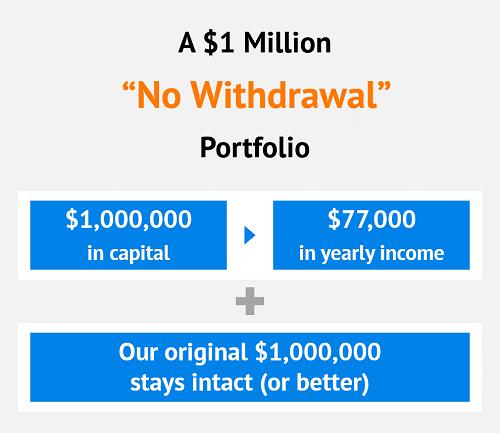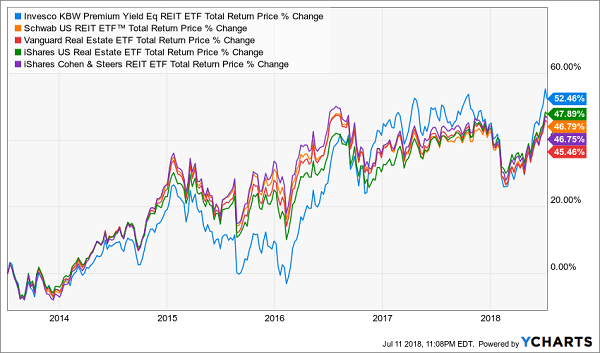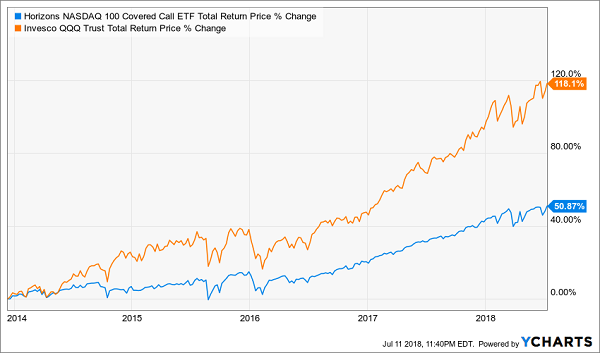What do most exchange-traded funds (ETFs) and many blue-chip stocks have in common?
They’re big, they’re popular with Wall Street pundits … and they don’t deliver nearly as much income as investors need to retire.
Not even close.
I want to share some ugly and eye-opening numbers with you about the skinflint ETF industry. I recently dug into the 100 most popular funds by assets under management, and here’s what I found:
- Just one of those 100 funds yields more than 7.7% – my threshold for a truly retirement-sustaining holding.
- Only about a dozen of those funds yield more than 3%.
- The average yield of those 100 funds is a meager 2.1%.
That makes for some ugly math for retirees. If you’re relying on your investment holdings to generate enough income to take care of the bills, and your funds are delivering just 2.1% … you’d better hope your kids have a spare room to stay in.
Even if you’ve managed to build up a million-dollar nest egg, you’re looking at $21,000 in annual income, which won’t even keep you in a decent studio apartment, let alone a comfortable home to enjoy in your post-career years.
This is why I recommend a strategy that helps you live on dividends only – without ever needing to sell a share to raise cash. My current “safe yield” stocks and funds deliver a 7.7% yield, which generates enough dividends for most investors to live off of (while enjoying price upside to boot):

But there’s a right way and a wrong way to secure 7.7% yields. (Really, a safe way and a dangerous way.)
Today, I want to show you some of the highest-yielding plays on Wall Street – including some duds to avoid, and some gems to consider. This is the route to a massive income stream built on diversified dividends you can count on long-term.
VanEck Vectors BDC Income ETF (BIZD)
Dividend Yield: 9.3%
Expenses: 9.67%
In theory, business development companies (BDCs) should be a yield hunter’s dream. Not only do they offer typically sky-high yields, but they’re in the business of financing small- and midsize firms. That should be a lucrative path to profits given continued growth in the American economy, not to mention tax breaks that should help prop up BDCs’ portfolio companies.
And yet …
The Market Is Lapping BDCs!

The environment for BDCs is just fine – but the lending business is getting increasingly crowded, making it difficult for most of the industry to keep profits up. It truly is an industry of a few haves and a lot more have-nots, and that’s a perfect storm that makes funds such as the VanEck Vectors BDC Income ETF (BIZD) counterproductive.
Typically, investors love ETFs because they can provide diversification – but in this case, casting a wide net in such a lousy industry means you’re catching a lot of junk. BIZD’s large collection of losers weigh down the few winners in the fund.
The reality is, there are only a few BDCs that are worth your hard-earned cash. Don’t touch this fund.
iShares Mortgage Real Estate Capped ETF (REM)
Dividend Yield: 10.2%
Expenses: 0.48%
The environment for mortgage REITs is downright dangerous today.
Market observers have been warning about how a flat yield curve (where short-term and long-term rates for bonds are similar) – or worse, an inverted curve (short-term rates are higher than long-term rates) – could be a troubling signal for the broader markets.
But that same setup is also lousy for mREITs, which will suffer higher borrowing costs as short-term yields continue to rise. Worse, they use leverage (debt) to juice their returns, which amplifies the risk of rising interest rates. And with the Federal Reserve happy to keep jacking up the fed funds rate, that risk isn’t abating anytime soon.
Profits are under siege, and dividend coverage is becoming increasingly problematic – especially worrisome since big dividends are the only real appeal of the sector right now.
For all these reasons, the iShares Mortgage Real Estate ETF (REM) is simply a “dead fund walking” right now. There may be a couple winners in its tight portfolio of about 35 stocks, but that’s no excuse to buy a fund like REM which, just like BIZD, is diluting its winners with a boatload of duds.
Invesco KBW Premium Yield Equity REIT Portfolio (KBWY)
Dividend Yield: 7.2%
Expenses: 0.35%
Not every collection of high-yield assets is a total dud, however. Take the Invesco KBW Premium Yield Equity REIT Portfolio (KBWY).
Unlike the Vanguard REIT ETF (VNQ), which is a collection of REITs that skews heavily toward the largest names in the space, this mouthful of an ETF only invests in small- and mid-cap real estate plays. So rather than, say, Simon Property Group (SPG) and American Tower (AMT), KBWY’s top holdings include the likes of Washington Prime Group (WPG), New Senior Investment Trust (SNR) and Government Properties Income Trust (GOV).
On top of that, the index has a modified yield-weighted methodology, which means higher-yielding components make up higher percentages of the fund at every rebalancing. That may have an effect similar to the Dogs of the Dow strategy, where the industrial average’s highest yields are also signals that those particular stocks are oversold and ready to bounce back.
This strategy has worked out for KBWY more often than not. While it’s not a world-beater, it does boast a modest performance edge against the most popular REIT ETFs on Wall Street.
Invesco’s KBWY Punches Above Its Weight Class

Horizons Nasdaq 100 Covered Call ETF (QYLD)
Dividend Yield: 9.7%
Expenses: 0.6%
You’d think that a fund yielding 10% that’s tied to the performance of the tech-heavy Nasdaq would be a total-return juggernaut.
You’d also be wrong.
The Horizons Nasdaq 100 Covered Call ETF (QYLD) allows investors to participate in covered calls – an options strategy that’s perfect for generating income in flat-to-down markets. In this specific case, QYLD holds the Nasdaq-100 – a collection of gigantic Nasdaq stocks including Apple (AAPL), Alphabet (GOOGL) and Microsoft (MSFT) – and sells calls against it.
But QYLD is a “dumb fund” that’s tied to an index and can only trade front-month options on the Nasdaq-100, severely limiting its flexibility and often forcing the ETF to close out contracts under less-than-ideal situations. Meanwhile, covered calls also limit the upside you can collect on upswings, and that’s a problem considering how much you’re leaving on the table by muting the performance of the Nasdaq-100’s high-growth tech stocks.
Only a Dumb Fund Could Mess This Up

If the Nasdaq ever stumbles for an extend period of time, maybe the QYLD will shine. But the odds are against you, so don’t be tricked into this nearly double-digit yield.
YieldShares High Income ETF (YYY)
Dividend Yield: 8.6%
Expenses: 2.02%
YieldShares High Income ETF (YYY) is a testament to the idea that sometimes, less is more.
The YYY is a “fund of funds” – specifically, a fund of closed-end funds (CEFs) that are geared toward numerous high-yield assets. The CEFs in this fund invest in everything from U.S. equities to emerging-market bonds to junk bonds to munis.
They’re good strategies on their own, but they’re mashed together in a way that amounts to overkill. More importantly, you’re not only eating the annual expenses of the YYY, but all of the various inherent fees from all the CEF holdings.
It’s an expensive way to access an 8%-plus yield, and it’s also not a terribly effective one.
YYY? But Why?

Since inception in June 2013, the S&P 500 has tripled up the YieldShares High Income ETF … not in price performance, but total returns!
Lock in the Best 7.7% to 8%+ Yields That Pay You Every Month
An 8% yield won’t help you out in retirement if it’s helping to make up for losses in the fund. But that’s exactly what you get with high-yield losers like the YYY.
That’s why you need more than just a yield number – you need quality funds behind it. And if that fund can drop those 8%-plus cash payouts into your account monthly instead of quarterly … all the better!
My brand-new 8% “Monthly Dividend” portfolio is built on a carefully crafted set of CEFs, high-yield preferred shares (again, from companies you know well) and well-established real estate investment trusts.
I just took the wraps off this rock-solid portfolio, and I’m ready to share it with you now — at no cost — when you click right here.
Thanks to its massive (and safe) 8% average yield, this powerful set of investments lets you kick-start an immediate $40,000-a-year income stream on a $500k nest egg.
That’s a 100%-reliable $3,333 dropping into your account every single month, with upside on your original investment to boot!
It really is a set-it-and-forget-it wealth-building machine.
To “swap out” your current dividend payers for this 8-stock powerhouse portfolio, you really need to do only 2 things:
- SELL EVERYTHING and …
- Buy the 8 bargain monthly dividend payers I’ll show you here.
That’s it!
Don’t be left out while other investors lock in their golden years with this powerful new portfolio. Simply CLICK HERE and I’ll give you all 8 of these stocks’ names, tickers, buy-under prices and more right now!
